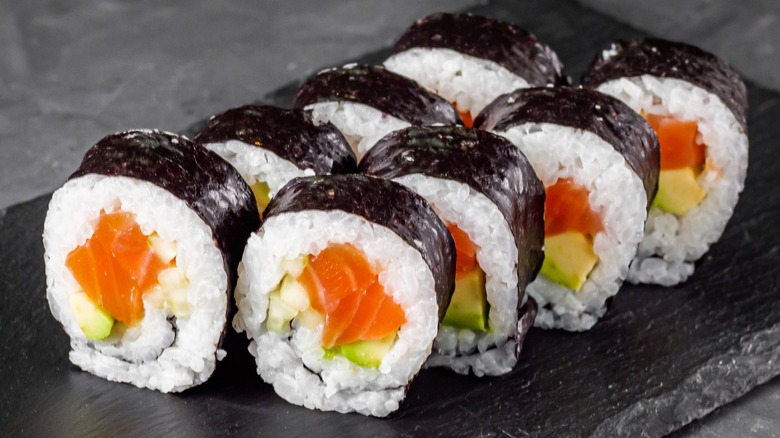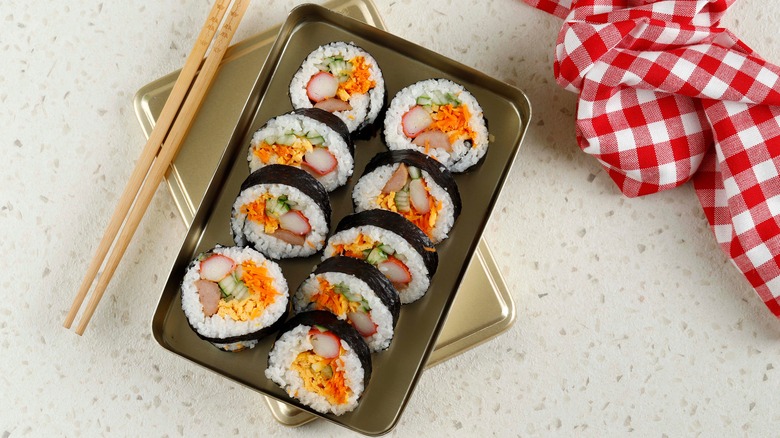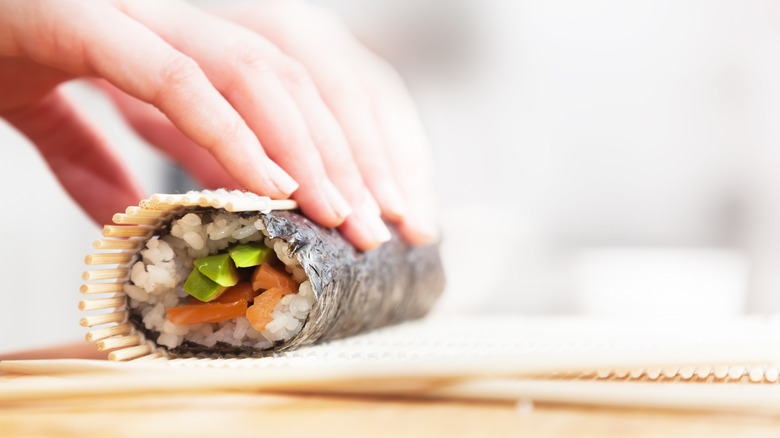Why You Shouldn't Try To Compare Kimbap And Futomaki
At first look, Korean kimbap and Japanese futomaki may look like culinary siblings, but don't make the mistake of saying kimbap is Korean sushi or vice versa, according to Taste. While their appearances are similar, their makeup has some key differences.
While both involve seaweed sheets wrapped around rice, the other fillings generally differ, as does the treatment of the rice. Taste says that the rice used in kimbap has been seasoned with sesame oil while the rice in futomaki is prepared the same as sushi rice and has vinegar added to it. Another key difference is what is inside of the two, with Japanese futomaki generally incorporating raw seafood and Korean kimbap boasting cooked ingredients. Both contain vegetables, but they tend to be country specific. The fillings for both futomaki and kimbap will vary depending on the cook's and the eater's preferences, according to Delish. And of course, the starkest difference might be that kimbap and futomaki originated in two different countries.
How and where kimbap and futomaki are eaten is yet another difference between the two rolls. In Korea, kimbap is a popular item to be packed in school lunches or for picnics, describes Maangchi, saying she loves to eat kimbap during special outings. However, futomaki is viewed as a little more elevated in Japan and is often brought to potlucks and festive gatherings, per Just One Cookbook, and is the main dish for Setsubun, a day of prayer, according to Japanese Cooking 101.
Kimbap may contain spicy tuna and braised burdock root
Full of flavorful ingredients, kimbap (also called gimbap) can be translated to mean seaweed rice from "kim" and "bap," respectively, according to Taste, which describes how sheets of seaweed are wrapped around rice and an assortment of fillings. While there are different varieties of kimbap, most contain a protein, an egg omelet, pickled radish, and crispy vegetables. Taste says the proteins are often first sautéed and can be beef bulgogi or pressed fish cake. Even spicy tuna can be used, according to a recipe from Delish. That recipe calls for canned tuna, mayonnaise, gochujang, and ground gochugaru (chili powder). Food Network opts for imitation crab in its kimbap, while Korean Bapsang says ground beef and ham can be used.
Even though it's up to the maker what is inside a kimbap roll, Delish says it's important that the ingredients should be a variety of colors. Ideally, a kimbap roll should contain around five ingredients. When including vegetables in kimbap, they are not left plain nor raw, but are individually treated. In Food Network's recipe, the spinach is blanched, and the julienned carrots are cooked with sesame oil and flavored with salt. Another traditional ingredient is braised burdock root, which can be bought prepared for kimbap, per Korean Bapsang. With so many already flavored ingredients incorporated into a kimbap roll, there is no need to dip it in soy sauce or drizzle other sauces on it.
Futumaki boasts unagi, shiitake mushrooms, and kanpyo
Futomaki is known for being a thick roll with a mix of common shelf-stable ingredients, as well as vegetables and fish, per Just One Cookbook. Some of the more commonly used cooked fish for futomaki are unagi (freshwater eel) and anago (saltwater eel). Generally, futomaki will include five ingredients, but can include 10 or more. Other popular ingredients, per Japanese Cooking 101, are dried gourd, shiitake mushrooms, spinach, and fish flakes. Like kimbap, slices of egg omelet and cucumber are also commonly found in futomaki, says The Spruce Eats. To make the egg omelet, eggs, sugar, and Canola oil are all used. The dried calabash gourd (kanpyo) also receives some treatment before being placed in the roll. First it is washed, rinsed, and drained before getting soaked for an hour to make it soft. The sliced kanpyo is cooked in a pot with dashi stock, soy sauce, sugar, and mirin.
While futomaki can contain a variety of ingredients that appeal to the cook, the most important aspect is that the flavors should be balanced, advises Just One Cookbook. And while its ingredients are flavorful, the finished roll is served with wasabi and pickled ginger, per MasterClass. In the end, the best futomaki will be filled with colorful ingredients and have flavors that blend well together.


